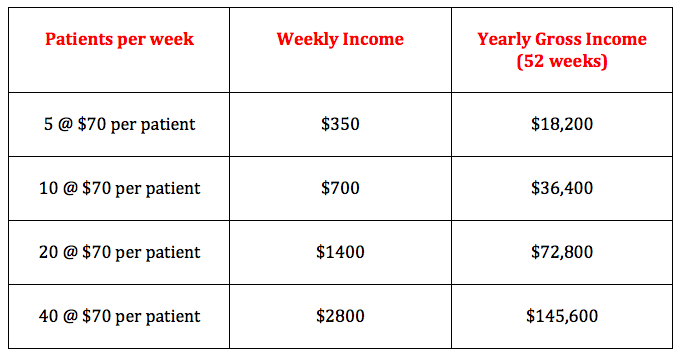 Recently, I received an e-mail from a practitioner who was considering purchasing an AcuGraph. She had a couple of really good questions for me. I’d like you to read my responses and tell me what you would add to my thoughts.
Recently, I received an e-mail from a practitioner who was considering purchasing an AcuGraph. She had a couple of really good questions for me. I’d like you to read my responses and tell me what you would add to my thoughts.
Background: This practitioner was responding to an e-mail which she received from me stating that my practice had doubled.
Question #1:
I’m interested in numbers. Telling me that your practice immediately doubled because you use the AcuGraph doesn’t really help me make a decision about the product. If you were seeing two patients a week, which then increased to four, that is doubling–but not really worth the costly investment. Can you tell me what doubling your practice means to you?
Question #2:
Secondly, what type of patients compose your practice? Seemingly, the AcuGraph could guide you to which meridian is involved in a painful situation, but what about fertility, weight loss, ADHD or autism?
My response…
Hello XXXXX,
I work for Miridia Technology three days a week, and treat patients in my private practice 2 days per week. This is a great balance for me, because it fulfills my need for research and continued educational growth, but it also allows me to treat patients regularly–which I really LOVE.
The growth of my practice since the AcuGraph came in two stages.
First:
When I first started working at Miridia, I allowed myself to treat 5 patients a week. Just enough to stay in touch with patients as I began this new endeavor. I immediately incorporated the AcuGraph into my private practice and used it as a “patient education tool.” Within a couple of months my practice doubled. That doesn’t sound like too much, does it? Going from 5 to 10 patients isn’t that big of a deal.
Second:
After about a year and a half, I had a paradigm shift. Finally, I realized that the AcuGraph was more than just a patient education tool. It was quite a transition for me. Once I made the transition, my patients started getting better twice as fast and my referral rate doubled. Currently, I am treating approximately 20 patients per week in my two-day a week practice. If a new patient called today, it would take 2.5 to 3 weeks to get in.
Considering that I only treat two days per week, this isn’t a bad place to be. If I had a full-time practice, I have no doubt that the results would be EXPONENTIAL. Think about it… Right now I’m very busy and don’t even have time for networking events and sending follow-up e-mails or newsletters for current patients.
If someone took what I do now and turned it into a four-day a week practice AND included all of the great follow-up steps that I’m not really doing, they would have a VERY successful practice. Let’s play with some numbers.
Two days a week is my limit right now. What is yours? I believe that a four-day a week practice can do numbers like this. I know many practitioners that treat A LOT MORE than 40 patients. Some charge less and some charge more. I picked $70 as an average because many patients also purchase herbs.
Here is the rest of my response to her e-mail:
What type of patients do I see?
This is a really great question. I used to think Meridian-style acupuncture was simply based on musculoskeletal complaints, and that I needed to treat internal problems from a TCM perspective. I learned by studying with Dr. Fratkin that I was wrong. The condition of the meridians can be detected in the meridian diagnosis (pulses or AcuGraph) and are directly related, not only to the channels or meridians, but also to the organs themselves.
I would say that 50% of my practice is based on musculoskeletal conditions, but the other half (if not more) is based on internal problems. In a typical week, I treat conditions such as menstrual disorders, depression, menopause, stress, insomnia, anxiety, fibromyalgia, chronic fatigue, obesity, etc. My first line of defense is ALWAYS to balance the graph. I have commonly found that 80% of a patient’s symptoms are alleviated by balancing the graph. Of course, once the needles are in for balancing the graph, I use whatever tools and techniques I have accumulated over the years—TCM, channel palpation, auriculotherapy, electrical stimulation, etc.
The take-home message is this: Once I started balancing the graph first, and then using my other tools, my patients got better faster. This is when my practice began it’s healthy flourish.
So, what do you think?
- Has your practice grown since you started using the AcuGraph? If so, how?
- Do you think that “Meridian Style Acupuncture” is only for musculoskeletal pain?
I appreciate your input. By sharing your responses, you are helping other practitioners to make a good decision for their practice. The success of each of us, turns into success for our entire field of medicine.
Have a great week!
Kimberly Thompson, L.Ac.



I have a question about the herbal component of AcuGraph. I am a 3 year graduate of a TCM program (herbs not offered). The TCM Association that I’m involved with says that because herbs was not a component of my TCM program, I’m not allowed to prescribe them. Will this be any different if I purchase an AcuGraph?
Herbal information will be added into the AcuGraph report, just like it would be added into any TCM text book. But–you will not be able to prescribe herbs unless you have the applicable license in your state to do so. We do not recommend that practitioners prescribe herbal formulas without having training and education in the field of Chinese Herbology.